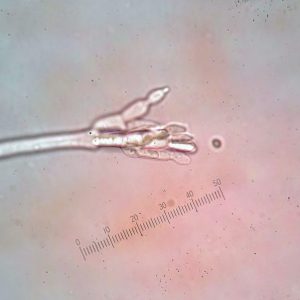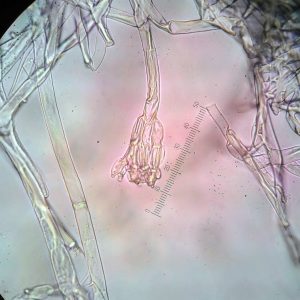Possible ID: Penicillium sp.
Classification:
Phylum: Ascomycota
Class: Eurotiomycetes
Order: Eurotiales
Family: Trichocomaceae
Isolation and Culturing Methods:
This specimen was isolated from soil samples in the Rooke Greenhouse, from a planter pot housing a Chenopodium oahuense plant. The soil was given a Nitrogen/Phosphorus blend four weeks prior to collection, and the greenhouse is kept at 26*C, >20% humidity and nightly UV light treatments. Specimen was grown in malt extract agar + chloramphenicol (MEA+C) for one week at room temperature, then hyphae that were not threatened by contamination were moved to a new sterile MEA+C plate and allowed to grow for another week.
Culture Appearance and Growth:
The morphology of this specimen on agar presented as an irregular radiation from the center, where mature hyphae form a dense light green/grey powder-like layer and new growth to the outside is white, patchy, and appears more filamentous. Hyphae are approximately 6 um in diameter, colorless and septate.
Spore Production:
Conidia structures include branches and metulae that both range from 8 to 12 um in length, and phialides from 5 to 8 um long. Spores are approximately 3 um in diameter, globose, and light green in color.


 1000x
1000x
***BLAST Analysis Results
Penicillium olsonii (100% qc)
P. olsonii is an anamorph species that produces several pectin enzymes and is a common cause of food rotting.